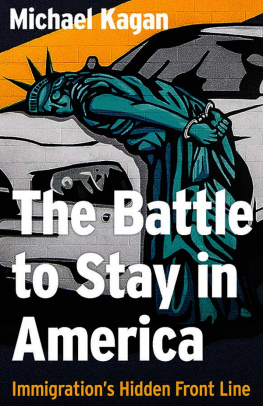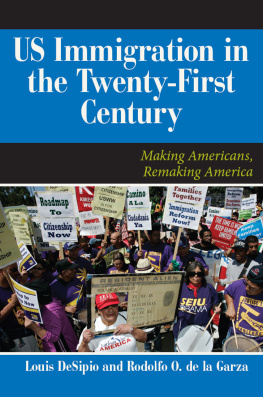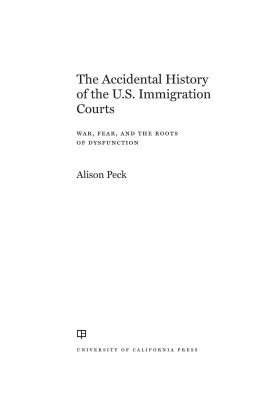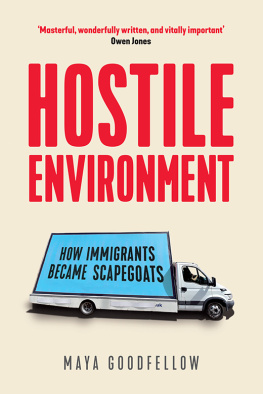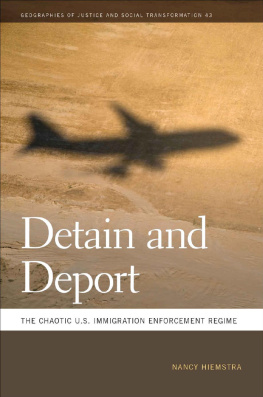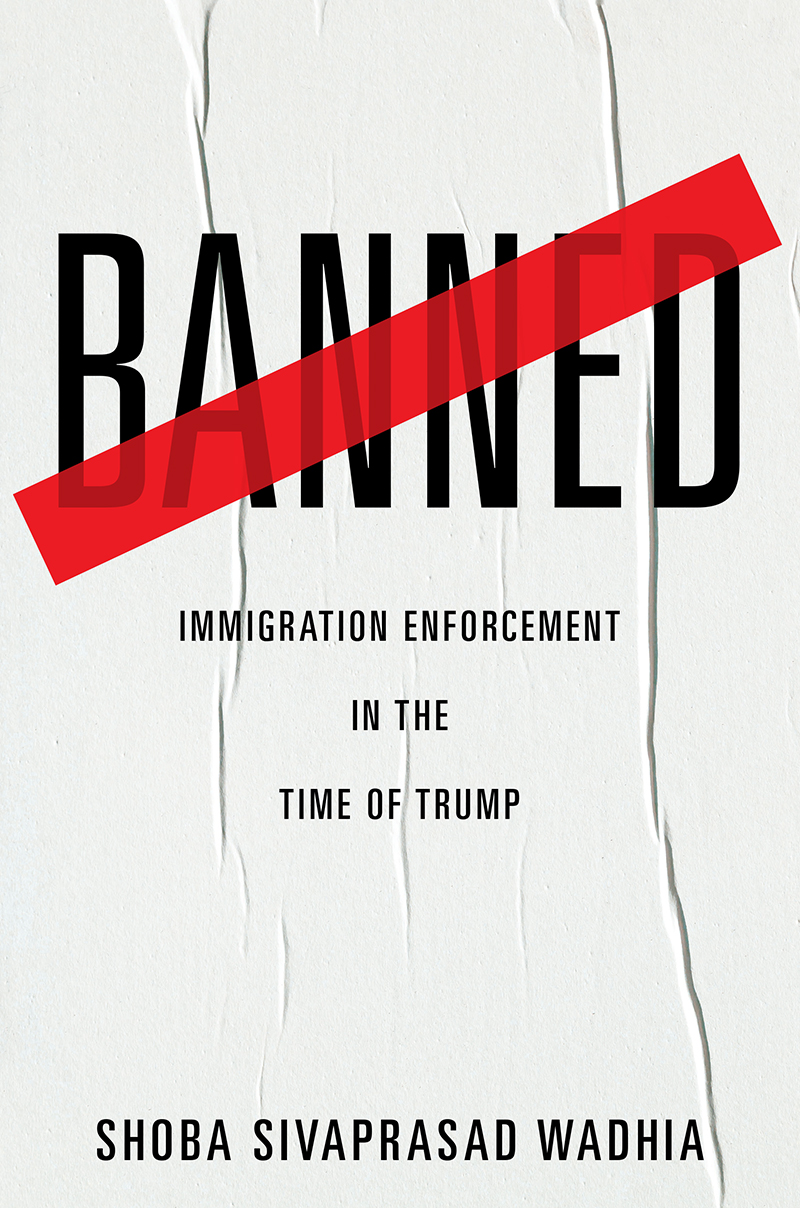
Banned
Banned
Immigration Enforcement in the Time of Trump
Shoba Sivaprasad Wadhia

New York University Press
New York
NEW YORK UNIVERSITY PRESS
New York
www.nyupress.org
2019 by New York University
All rights reserved
References to Internet websites (URLs) were accurate at the time of writing. Neither the author nor New York University Press is responsible for URLs that may have expired or changed since the manuscript was prepared.
Library of Congress Cataloging-in-Publication Data
Names: Wadhia, Shoba Sivaprasad, author.
Title: Banned : immigration enforcement in the time of Trump / Shoba Sivaprasad Wadhia.
Description: New York : New York University Press, [2019] | Includes bibliographical references and index.
Identifiers: LCCN 2018055367| ISBN 9781479857463 (cl ; alk. paper) | ISBN 1479857467 (cl ; alk. paper)
Subjects: LCSH: Emigration and immigration lawUnited States. | RefugeesLegal status, laws, etc.United States. | Administrative discretionUnited States. | United StatesEmigration and immigrationGovernment policy.
Classification: LCC KF4819 .W235 2019 | DDC 342.7308/2dc23
LC record available at https://lccn.loc.gov/2018055367
New York University Press books are printed on acid-free paper, and their binding materials are chosen for strength and durability. We strive to use environmentally responsible suppliers and materials to the greatest extent possible in publishing our books.
Manufactured in the United States of America
10 9 8 7 6 5 4 3 2 1
Also available as an ebook
For Hemal, Devyani, and Neelesh
Contents
Immigration Enforcement and Discretion
A Primer
Every day, officers and employees within the Department of Homeland Security (DHS) carry out immigration laws. Congress created DHS as a cabinet-level agency in the wake of the September 11, 2001, terrorist attacks.
A third unit within DHS is called U.S. Citizenship and Immigration Services (USCIS).
Congress enacted the INA in 1952. It has been compared second in complexity to the U.S. tax code. While the language has been amended over the years, the immigration statute remains the primary framework
One goal Congress had in creating DHS was to separate the immigration enforcement and service functions once held under one umbrella in an agency known as Immigration and Naturalization Service (INS). In reflecting on the creation of DHS and how it functions in the time of Trump, government official 2, based on the East Coast, who formerly served in INS, shared, One of the greatest ironies to me is that one of the arguments for breaking up the INS was that you need to split the service and enforcement because the enforcement was polluting the service side of the business. And that the service side of business was too enforcement minded. Well, now that its all in the Department of Homeland Security, look at what were seeing coming out of USCIS in the current era. You see an enforcement outlook and actions that USCIS is taking that would never have happened in INS days.
Immigration enforcement is not limited to deportation or what is formally called removal. Instead, there are ranges of actions that are considered enforcement. For example, street arrests, interrogation at a workplace, detention in a correctional facility, and prosecution as a trigger for removal proceedings are all actions that constitute immigration enforcement. DHS statistics indicate that in fiscal year 2016, one arm of ICE known as Enforcement and Removal Operations (ERO), booked about 350,000 people into detention and that DHS removed 340,000 noncitizens.
The details of the immigration law and the agencies responsible for carrying them out are indeed complexbut the role of discretion is also significant. As Justice Anthony Kennedy noted in Arizona v. United States, Discretion in the enforcement of immigration law embraces immediate human concerns.... The equities of an individual case may turn on many factors, including whether the alien has children
Discretion is interwoven with deportation. Immigration scholar Daniel Kanstroom identifies three forms of discretionprosecutorial, ultimate, and interpretative, all three of which are addressed in this book. Importantly, DHS has the prosecutorial discretion to refrain from taking action against a person at each enforcement stage. For example, if an ICE officer chooses to not detain a woman who is pregnant or nursing but who legally qualifies for detention, discretion is being exercised favorably.
Prosecutorial discretion is necessary because the government has limited resources it can use to carry out enforcement against noncitizens. According to the former director of ICE, in 2011, ICE has the resources to deport less than 4 percent or 400,000 of the roughly 11.2 million people living in the United States without authorization today. This number does not include the many lawful permanent residents (green card holders) who are eligible for immigration enforcement because of post-entry conduct.
As showcased in my first book, Beyond Deportation, the government has exercised discretion for largely humanitarian reasons that include a persons family ties, age, or medical condition. Deferred action is one kind of prosecutorial discretion that existed for decades but came to light with President Barack Obamas announcement of Deferred Action for Childhood Arrivals (DACA). DACA is a policy that was implemented by the secretary of Homeland Security and enabled nearly 800,000 people who came to the United States before the age of sixteen, have continuous residence, and are in school or graduated to receive deferred action for a renewable period of two years.
Deferred action is not the only way prosecutorial discretion can be exercised. Before a court hearing, DHS may exercise discretion by choosing not to bring charges against individuals who overstay their visa. After an immigration judge decides to grant asylum, DHS may exercise discretion by choosing not to file an appeal. DHS may also choose to grant a stay of deportation after a person has been ordered removed. Finally, DHS may exercise prosecutorial discretion invisibly. For example, discretion is opaque when DHS chooses not to enter a schoolhouse to carry out an enforcement action or chooses not to arrest a person who clearly lacks immigration status. The discretion exercised by DHS employees is often framed by memoranda and guidelines by the DHS secretary or the agency heads within ICE, CBP, and USCIS. For example, DACA requests are processed by USCIS and must satisfy a set of requirements set forth in a DHS memorandum for anyone seeking deferred action under DACA.
Beyond the significant relationship between prosecutorial discretion and immigration enforcement is the prominence of discretion in other immigration domains. DHS officers may be required to consider discretion or the balancing of positive and negative factors when deciding whether to grant someone a green card, asylum, or a waiver. For example, asylum seekers must prove that they have suffered persecution in the past or face a well-founded fear of persecution in the future because of race, religion, nationality, political opinion, or membership in a particular social group and further must show that they qualify for asylum as a matter of discretion. As explained in chapter 6, guidance from USCIS seeks to expand the number of discretionary denials made by asylum officers in certain asylum cases.
Next page



